
Ko Bizen Tomasa
JT0011
SOLD
Rare and important zaimei tachi by Ko Bizen Tomasa, either the son or grandson of Ko Bizen Masatsune. Shirsaya with Homma Kunzan Sensei sayagaki, two piece mon zukashi habaki of solid gold and gold foil.
Tachi signed niji mei Tomasa. Nagasa 70 cm (27.5625"). Sori 2.3 cm (0.9375"). Motohaba 2.5 cm. Sakihaba 1.6 cm. Kissaki nagasa 2.2 cm. Nakago nagasa 19.3 cm. Nakago zori 0.2 cm.
"Tsukurikomi: Shinogi zukuri iori mune, mihaba and kasane give a slender blade consistent with the era, there is abundant hiraniku, and ko-kissaki, is a beautiful tachi sugata with koshi-zori, and marudome bohi is engraved on the omote and ura in the shinogi ji. Kitae: Very tight ko-itame with a hint of itame nagare, with very fine ji-nie, midare utsure stands out, and there is abundant chikei. Hamon: Nioi deki, mainly a choji tone with gunome midare mixed in, habuchi is bright, with abundant nioi ashi. Boshi: Becoming suguba returning slightly in an o-maru style. Truly high quality. Nakago: Suriage, the original nakago was about 2 sun 5 bu, generously niku-oku, strong with large mekugi ana, mei is in its upper portion, and meiji are inscribed as two kanji in an ancient elegance. TOMASA is KO-BIZEN, and is said to be the son or younger brother of TOCHIKA. Called OSHU GORO, around KOAN (1278-1288)" Translated by Harry Afu Watson from OSHIGATA SHU illustrated below.
NOTE: As it is in the case of Ko Hoki, there is some question about the actual dates of Masatsune and his school. Traditional scholarship dated Ko Bizen Masatsune to Heian jidai, around 1000 A.D., which in turn would date this smith to around 1040.

Ko Bizen Tomasa
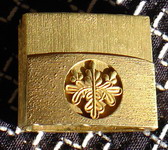
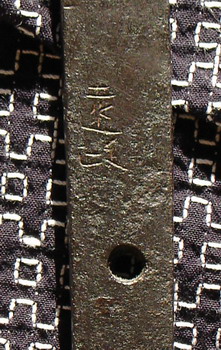

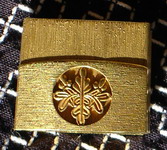
Zaimei Tomasa & Kiri Mon Sukashi Habaki


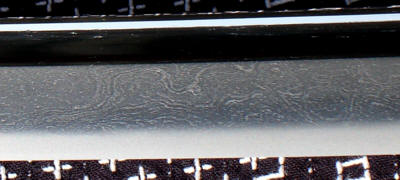
Tomasa Jigane
FROM JUYO TOKEN NADO ZUFU #45, TRANSLATED BY HARRY AFU WATSON
Harry Watson
afu@afuresearch.com
"Keijo: Shinogi zukuri, iori mune, slender blade, with high koshi-zori, there is fumbari, ko-kissaki. Kitae: mokume mixed in itame, with a fair amount of ohada mixed in, hadatachi (vivid or pronounced grain -- literally "standing") with ji-nie, midare utsture stands out. Hamon: Choji and small notare mixed in gunome, the lower half becomes a suguba tone, with ashi and abundant ko-nie, a slight amount of kinsuji inserted. Boshi: Slightly notare, the omote is maru, the ura returns with a hint of ko-maru. Horimono: On the omote and ura, bohi are marudome (round end) beneath the habaki. Nakago: Suriage, saki is kurijiri, yasurime is sujikai, two mekugi ana, on the omote towards the mune and above the orginal mekugiana there is a nijimei done in fine tagane.
Explanation: TOMASA, according to the Meikan, is said to be a pupil or the son of TOCHIKA, and was a tosho in the MASATSUNE Kei, which is considered to be in the nagare of Ko-Bizen, the period is about Koan (1278-1288). Extant signed works by TOMASA are extremely rare, but on the other hand, there are a number of signed pieces by TOCHIKA still in existence. In taking a general view of these, for the work style, some that area flowery choji midare, some that are a choji mixed in gunome of smaller pattern, and some that are suguba. He can be said to be a toko with a fairly broad range in his work style.
As for this tachi by TOMASA, the kitae is mokume mixed with itame, the hada pattern is fairly large, with ji-nie, and midare utsure stands out. The hamon is choji and ko-notare mixed in gunome, the difference between the peaks and valleys is small, and the lower half is a suguba tone. From these points, similarities can be seen with TOCHIKA from the standpoint of work style, and the fact that the shape of the ji for TO is very similar with the two, the statements in the Meikan can be supported. This extant rare remaining example of TOMASA is valuable from the standpoint of data."

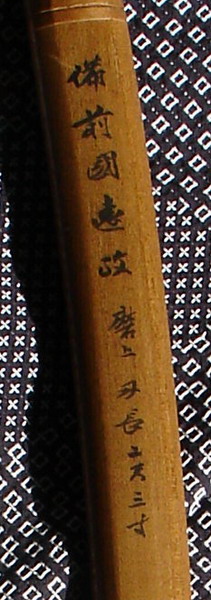

Sayagaki by Homma Kunzan Sensei
425